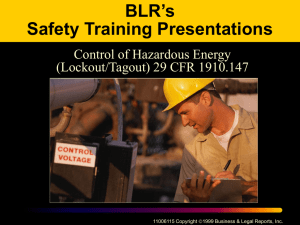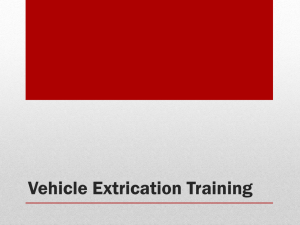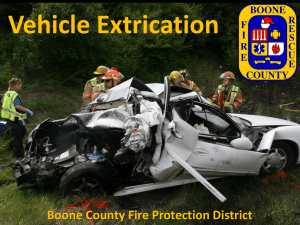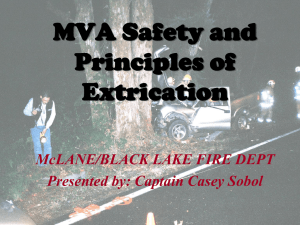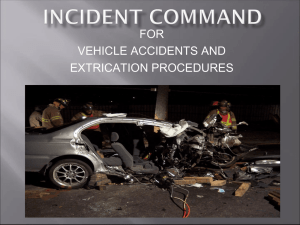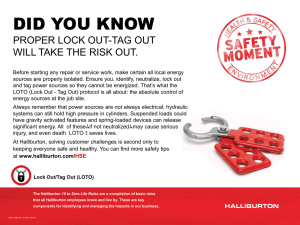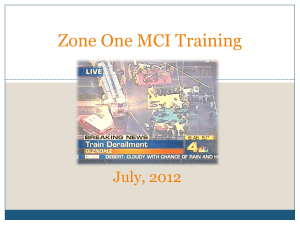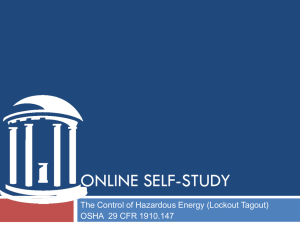Vehicle And Machinery Extrication
advertisement
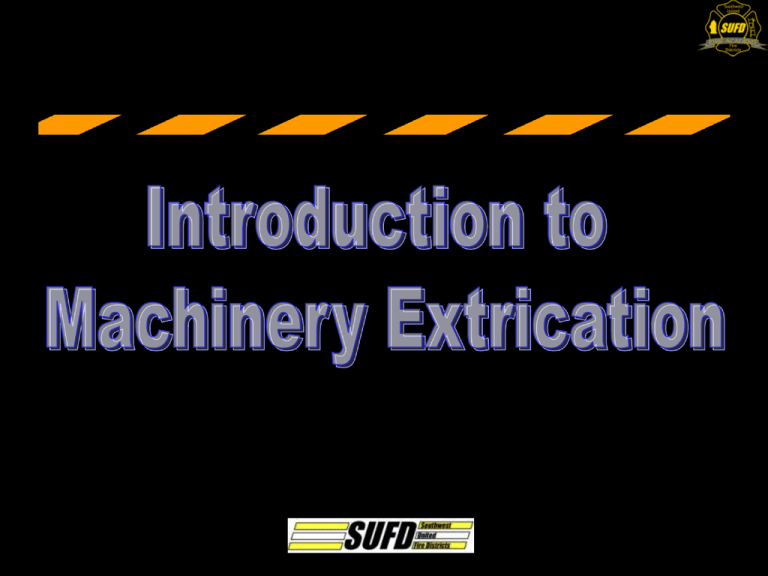
Course Name – Unit Title Welcome • MABAS Division 10 – Monthly In-service Training Sessions – Sponsored by MABAS 10 Training Officers Committee Course Name – Unit Title • Today’s Instructor – Lt Don Kaderabek • Niles FD • SUFD Staff Instructor Today’s Objectives The Rescue Technician candidate shall: Correctly describe the process of stabilization of the machinery or equipment in order to prevent unwanted movement or operation. Correctly identify the need for a secondary survey of the area of operation, and the stabilized equipment or machinery. Course Name – Unit Title Today’s Objectives The Rescue Technician candidate shall: Correctly identify the four factors to be addressed in the extrication of a patient from machinery or equipment. Correctly identify the three basic means which can be used to extricate the patient from the machinery or equipment. Course Name – Unit Title Today’s Objectives The Rescue Technician candidate shall: Correctly identify the need for retrieval, and cleaning of tools, as well as their return to service. Correctly describe the process of surveying the scene to ensure that it is left in a safe, and secure manner. Course Name – Unit Title Practical Skill Demonstration • Extricate an extremity that is trapped in a belt driven conveyor or roller conveyor with the tools normally found on the first arriving fire company. Course Name – Unit Title References • NFPA 1006 – Professional Qualifications for Rescue Technician • NFPA 1670 – Training Requirements for Technical Rescue Personnel • Machinery Extrication Objectives Course Name – Unit Title Machinery Rescue Potential • Where in your community or mutual aid response area • What are your rescue capabilities – – – – – Heavy lifting For Equipment and Components Cutting operations that may weigh several thousand pounds to several tons!! Disassembly Stabilization Securing energized equipment Course Name – Unit Title Types of Incidents • • • • • Arm in dough press Arm in printing press Child stuck in a safe Finger stuck in fuel fill port Child’s leg in bicycle spokes Course Name – Unit Title Tools Needed • Battery Operated Tools – Reciprocating – Impacts – Drill – Circular saw (metal cutting) • Wood & Steel Wedges • Lock-out / Tag-out Equip. • Saw • Chains Course Name – Unit Title • Soap Solution • Pry bars • Hydraulic tools – Spreader – Rams – Cutters • Air tools – Bags – Chisel – Ratchet / socket • Assorted Hand Tools – screw drivers, wrenches, pliers, hammers Course Name – Unit Title Pre-Incident Planning • Due to the variety of equipment, specific rescue techniques will vary • Pre-planning is key to success • Differs from procedural approach as in vehicle extrication • Plan should consider: • Maintenance personnel • Location of Operating Instructions and manuals Course Name – Unit Title Pre-incident plan • Plan should consider: – Number, types, locations of machinery at specific location – Types of power sources and their cutoffs – Hazard potential of materials or chemical used Course Name – Unit Title Pre-incident plan • Plan should consider: • Maintenance personnel on-site • Locations of diagrams or drawings • Equipment on hand that can be used • Manufacturer contact information Course Name – Unit Title Industrial Extrication • Scene survey – First step in any extrication – Use same concept as auto extrication – Rescue officer and one rescuer should proceed to the scene while rest of team waits for further instructions Course Name – Unit Title Industrial Extrication • Scene survey – Rescue officer evaluates: • Condition of victim (ABCs) • Degree of entrapment • Number of rescuers required • Type of equipment needed • Any special personnel or equipment needed Course Name – Unit Title Industrial Extrication • Scene survey – Rescue officer evaluates: • Any expert assistance required • Any other hazards present • Level of fire present • Assume all electrical situations are energized • Cordon off the incident site Course Name – Unit Title Industrial Extrication • Seek expert assistance – Equipment may be beyond expertise of rescue personnel – Experts may include: • Equipment operators • Maintenance personnel • Equipment manufacturer Course Name – Unit Title Industrial Extrication • Neutralize power sources – Shut down power when working around machinery – Ask if machine is full cycle/press type that must complete its full range of motion before it can be stopped – Primary power source is normally electrical Course Name – Unit Title Industrial Extrication • Neutralize power sources – Identify other power sources used by the machinery • Hydraulic (fluids under pressure) • Pneumatic (compressed air) • Stored energy in springs • Potential energy from suspended parts Course Name – Unit Title Industrial Extrication • Neutralize power sources – If safe to isolate power, lockout/tagout IAW 29 CFR 1910.147 and local SOPs • Station a rescuer at power source with a radio • Isolate any other power sources • Prevent any source of movement • Block parts Course Name – Unit Title Industrial Extrication • Stabilize Machinery – The majority is accomplished during neutralization – Further stabilization may be needed – Cribbing used for automobiles may not be sufficient Course Name – Unit Title Industrial Extrication • Stabilize Machinery – Survey again • After power neutralization and stabilization, victim may be able to be freed • Repeating these steps may point out more problems than first realized Course Name – Unit Title Industrial Extrication • Extricate the victim – Extrication begins only after zero mechanical state achieved – 4 critical factors to consider • Time • Victim • Rescuer • Machine Course Name – Unit Title Industrial Extrication • Extricate the victim – Zero mechanical state means there is no way the machine can operate without the systems being restored Course Name – Unit Title Extricating the Victim • Industrial extrications fall into 3 categories: – Manipulative – Disassembly – Force the machine Course Name – Unit Title Industrial Extrication • Manipulative • Simplest and quickest • Where victim is manipulated • Where machine is manipulated • Limited to degree of entrapment Course Name – Unit Title Industrial Extrication • Disassembly –Most common approach –May require special tools Course Name – Unit Title Industrial Extrication • Force the machine – Least desirable – Ensure you have appropriate tools for the job Course Name – Unit Title Industrial extrication • Equipment retrieval – Rescuer safety is of primary importance – If equipment cannot be moved without endangering rescuers, leave it in place – Inspect equipment for damage and service as required Course Name – Unit Title Industrial extrication • Securing and restoring the scene – Local protocol dictates who is to restore an emergency scene – When all hazards are eliminated, lockout/tagout devices can be removed at the discretion of the IC or plant manager Course Name – Unit Title Industrial extrication • Securing and restoring the scene – If any hazards still exist • Inform owner/manager • Review actions taken by rescuers • Review suggestions to prevent future incidents • Have owner/manager sign written release Course Name – Unit Title MR. TASK Medical degree of patient and degree of entrapment Rescue personnel needed to complete the job Type and amount of extrication equipment needed Assistance from haz-mat, medics, doctors, etc. Specialized equipment and/or operators Kind of life hazards present fire, haz-mat, water, electricity, etc Course Name – Unit Title “LOCK OUT” Course Name – Unit Title ADDITIONAL POWER SOURCES Additional power sources which may need to be neutralized: Equipment Hydraulic fluids under pressure Compressed air Energy stored in springs Potential energy from suspended parts Any other sources which might cause unwanted movement Course Name – Unit Title CONSIDER..... Factors which need to be considered during the secondary survey: Patient Need for pain management Possibility of drastic, life-saving measures Need for psychological support for victim(s) Course Name – Unit Title MEANS OF EXTRICATION Manipulative Extrication Course Name – Unit Title MEANS OF EXTRICATION Disassembly of the Machine Course Name – Unit Title MEANS OF EXTRICATION Forcing the Machine Course Name – Unit Title Course Name – Unit Title Course Name – Unit Title Course Name – Unit Title Course Name – Unit Title Course Name – Unit Title Course Name – Unit Title Course Name – Unit Title Course Name – Unit Title Course Name – Unit Title Course Name – Unit Title Course Name – Unit Title Course Name – Unit Title Course Name – Unit Title Control of Hazardous Energy (Lockout/Tagout) 29 CFR 1910.147 BLR’s Safety Training Presentations Course Name – Unit Title What Is Lockout/Tagout? • Referred to as LOTO • Blocks flow of energy from power source to the equipment • Provides means of warning (tag) Course Name – Unit Title Regulatory Requirements • 29 CFR 1910.147–Control of Hazardous Energy • Covers operators and service personnel • Requires training of employees Course Name – Unit Title Types of Lockout Devices • • • • • • Locks Blocks Chains Multilock hasps Wheel valve covers Ball valve covers Course Name – Unit Title 11006115 Copyright 1999 Business and Legal Reports Inc. Requirements For Lockout/Tagout Devices They must be: • Durable • Standardized • Substantial • Identifiable Course Name – Unit Title Energy Sources • • • • • • • Electricity Hydraulic Pneumatic Steam Thermal Chemical Gravity Course Name – Unit Title Typical Equipment Requiring LOTO • • • • • Presses Saws Conveyors Pumps Production Equipment • Trash Compactors • Ovens Course Name – Unit Title 11006115 Copyright 1999 Business and Legal Reports Inc. When Must LOTO Be Used? When servicing or maintaining equipment where: • Hazardous energy exists • Unexpected start-up could occur • Either of these could harm an employee Course Name – Unit Title LOTO Shall Be Used When: • Employees are required to remove or bypass a safety device • Employees are required to place any part of their body in harm’s way • Employees are exposed to hazardous energy Course Name – Unit Title LOTO Exceptions • Work where hazardous energy does not exist • Activities performed during routine production processes • Work on cord-controlled devices • Hot tap operations where shutdown is not feasible Course Name – Unit Title Typical LOTO Procedures • Performing a shutdown • Isolating equipment • Applying and removing lockout devices • Safely releasing stored energy Course Name – Unit Title Affected Employees Employees who • Operate • Work around • Occasionally adjust equipment that is subject to LOTO Course Name – Unit Title Authorized Employee • Maintains equipment • Services equipment • Is trained to use LOTO Course Name – Unit Title 11006115 Copyright 1999 Business and Legal Reports Inc. Company Responsibilities • • • • • • Ensure de-energization of equipment Ensure employee awareness Provide appropriate levels of training Review program effectiveness Maintain and revise program Administer appropriate disciplinary actions Course Name – Unit Title Maintenance Responsibilities • Lockout/Tagout prior to service or repair • Remove or cut locks off isolation devices • Ensure proper training of authorized employees Course Name – Unit Title 11006115 Copyright 1999 Business and Legal Reports Inc. Affected Employee Responsibilities • Notify maintenance, etc., when equipment needs repair or adjustment • Leave all LOTO devices in place • Verify equipment is safe to operate following LOTO • Follow all safety rules while operating the equipment Course Name – Unit Title Authorized Employee Responsibilities • Repair or service equipment as needed • Ensure that all energy sources are locked out • Test equipment to verify residual energy is dissipated • Place a “Danger—Do Not Operate” tag on equipment Course Name – Unit Title Authorized Employee Responsibilities (cont.) • Obtain assistance when necessary • Remove locks and/or tags following LOTO • Coordinate multi-shift repair Course Name – Unit Title 11006115 Copyright 1999 Business and Legal Reports Inc. Training Requirements • Authorized employees—initially and at least annually • Affected employees—at least initially • Authorized and affected—whenever changes are made to jobs or procedures • Authorized and affected—when program deficiencies are noted Course Name – Unit Title How to Perform LOTO Safely • Follow company safety procedures for LOTO • Refer to procedures on how to lockout specific equipment • Keep everyone informed when equipment is repaired or serviced • Stay alert • Use common sense Course Name – Unit Title Quiz 1. The LOTO standard is designed to block the flow of energy to a piece of equipment. True or False 2. Types of LOTO devices include _______, _______, and _______. 3. It is not required that a company have written procedures for proper lockout/tagout. True or False 4. An authorized employee is one who _________ or _________ the equipment. Course Name – Unit Title 5. If a safety device is11006115 removed from a piece of Copyright 1999 Business and Legal Reports Inc. Quiz (cont.) 6. Typical energy sources found on equipment include: _______, _______, and _______. 7. Affected employees are those who operate or work around a piece of equipment. True or False 8. As long as an employee has had training on LOTO, the employer or company has no additional responsibilities under 1910.147. True or False 9. Training for authorized employees must be conducted _________ and at least _________. Course Name – Unit Title 11006115 Copyright 1999 Business and Legal Reports Inc. Quiz Answers 1. True. It should block the flow of energy and provide a means of warning. 2. Types of LOTO devices include locks, blocks, chains, hasps, wheel valve covers and ball valve covers. 3. False. If lockout is required, a company must have a written program and procedures. 4. An authorized employee is one who services or maintains the equipment. Course Name – Unit Title 5. False. LOTO is required when a safety device is 11006115 Copyright 1999 Business and Legal Reports Inc. Quiz Answers (cont.) 6. Typical energy sources include: electricity, hydraulics, pneumatics, steam, thermal, chemical and gravity. 7. True. Affected employees are those who operate or work around the equipment. 8. False. Training is just one of the responsibilities of a company. 9. Training for authorized employees must be conducted initially and at least annually. 10. False. Locks should be removed during shift Course Name – Unit Title change and the shift coming on duty should 11006115 Copyright 1999 Business and Legal Reports Inc. Types of Machinery Industrial, Construction & Agricultural Course Name – Unit Title Milling Machine Course Name – Unit Title Break Press Course Name – Unit Title Lawn Tractor Course Name – Unit Title Know The Controls Course Name – Unit Title Tractor Rollover! Course Name – Unit Title Tractor! Course Name – Unit Title Remote Locations Course Name – Unit Title How do we shut it down? Course Name – Unit Title How do we stabilize? Course Name – Unit Title How do we stabilize? Course Name – Unit Title How do we stabilize? Shut Down Chain Tires Side Stabilization Course Name – Unit Title How do we stabilize? Course Name – Unit Title Plan – A, B, C Course Name – Unit Title Plan – A, B, C Bottle Jacks have a limited lift height and small surface contact Course Name – Unit Title Mangled Course Name – Unit Title Mangled Course Name – Unit Title Find The Part Course Name – Unit Title Mangled Course Name – Unit Title Mangled Course Name – Unit Title Find The Part Course Name – Unit Title In Plant Facilities • Always check with on site maintenance personnel , they know the LOTO points and hazards of the equipment • For LOTO consider a computer terminal in todays automated world to shut down machinery production lines. • Electric fans and or smoke ejectors may be used to reduce the temperature in the machinery area. Course Name – Unit Title Course Name – Unit Title Course Name – Unit Title Walmart • When shutting down the power in a Walmart you must contact the corporate office. • They have an overide to all stores at corporate. • If you shut the power down locally it can be brought back on remotely without your knowledge! Course Name – Unit Title Safety • Slick oily surfaces are common in most plants-consider using some oil dry to reduce personnel and air bags from slipping. • Consider the use of overhead cranes for use and as anchor points. • Confined spaces may require monitoring and ventilation. Course Name – Unit Title Safety • Other machines in operation may have to be shut down due to vibration, noise or rescuer safety. • Have a plan to guide incoming resources and EMS, sometimes there is a closer entrance than the one you were directed to. • When working with heated objectsremember latex EMS gloves can deteriorate due to heat. Course Name – Unit Title
